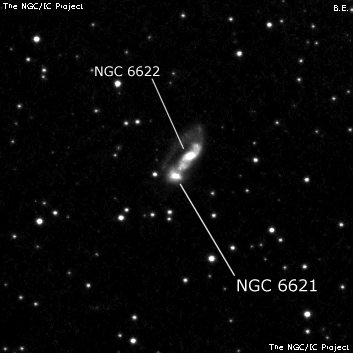NGC/IC Project Restoration Effort
(This is a very very beta version)
NGC6621


Basic Information
Location and Magnitude
Right Ascension: 18:12:55.6
Declination: +68:21:47
Constellation: DRA
Visual Magnitude: 13.6
Historic Information
Discoverer: Swift E.
Year of discovery: 1885
Discovery aperture: 16.0
Observational
Summary description: pF, pS, R, lbM, s of 2
Sub-type: Sb/P
Corwin's Notes
=====
NGC 6621 and NGC 6622 are a well-known interacting pair (Arp 81 = VV 247). In
spite of the NGC's explicit note (from Swift) that NGC 6621 is the "s of 2",
there has been confusion about the numbers as the southern galaxy is the
southeastern of the pair. Thus, the numbers are indeed out of RA order.
This is also a pair that Swift announced twice. It was apparently first seen
by his son, Edward -- curiously, Edward's name appears only on the northern
object -- on 2 June 1885. (If the dates given in Swift's first list are
correct, this is the third nebula found by Edward Swift.) Lewis Swift himself
claims the second "discovery" on 11 Aug 1885. Neither set of positions is
very good, but Dreyer, apparently unlike Swift, recognized that the
observations referred to the same pair of nebulae. He used simple mean
positions for the NGC; those are about 2 arcmin southeast of the galaxies,
good enough to find the pair.
Steve's Notes
=====
NGC 6621
48" (5/5/16): at 610x and 697x; NGC 6621/6622 is a spectacular interacting system (Arp 81 = VV 247) with an amazing tidal tail that wraps around both galaxies. NGC 6621 is sharply concentrated with a very bright, roundish core that increases to the center. The main halo or arms is elongated ~3:1 NW-SE, ~60"x20" with slightly brighter "handles" (ends of the spiral arms) on the NW and SE end. The enhancement on the NW side is more evident.
The southeast end merges with the halo of NGC 6622 with the cores of the galaxies separated by 40". A very small knot (at most 10" in size) was visible on a line between the two cores [16" NW of NGC 6622 and 26" SE of NGC 6621]. The HST image reveals this is a prominent blue starburst complex at the edge of the two galaxies.
On the northwest end, a broad tidal arm wraps sharply counterclockwise to the southeast (the arm is easily visible in this part), dims into a narrow tail and extends southeast, paralleling (about 30" to the east) the major axis of NGC 6621. This one-sided tail extends ~1.5' in length in the direction of a mag 15 star due east of NGC 6622 and ends in a slightly brighter knot, ~25" NE of NGC 6622.
48" (10/22/11): at 488x the main body of NGC 6621, which completely merges with NGC 6622, appears bright, fairly large, elongated nearly 3:1 NNW-SSE, ~1.1'x0.4'. Including NGC 6622 at the southeast end, the entire glow extends ~1.6'x0.4'. NGC 6621 is fairly sharply concentrated with a bright 20" core that gradually increases to the center. At 610x, a faint spiral arm is fairly evident attached at the NNW end and winding around counterclockwise to the north side of the main glow. On the HST image this is the beginning of a long tidal tail that wraps around the north side of both galaxies.
18" (7/14/07): fairly faint, fairly small, elongated 5:2 NW-SE, ~1.0'x 0.4', small bright core. Brighter of a double system with NGC 6622 (Arp 81) attached at the southeast end in a common envelope. The two nuclei of the galaxies generally appear as two knots near the ends of a single elongated bar though at moments the pair seems barely resolved.
17.5" (6/11/88): fairly faint, small, irregularly round, small bright core, stellar nucleus. Forms a double galaxy in a common envelope with NGC 6622 just 40" SE of center. A mag 15 star is 30" E.



